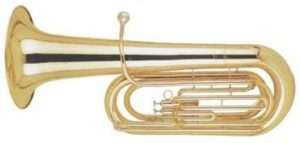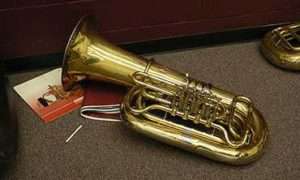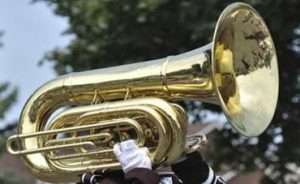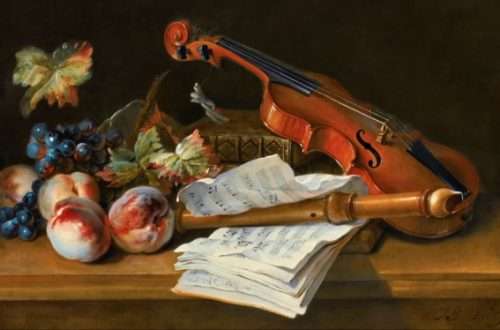
History Ball
Tuba – the youngest musical instrument from a number of brass wind instruments and the lowest in register among its kind. The new instrument was created in Germany by craftsmen W. Wiepricht and K. Moritz. The first tuba was made in 1835 in the musical and instrumental workshop of Moritz.  However, the valve mechanism was created incorrectly, as a result, the timbre at first was harsh, rough and ugly. The first tubas were used only in “garden” and military orchestras. Another great instrumental master, Adolphe Sax, managed to improve, make it the way we know it today, give it a real orchestral life after the instrument came to France. Having selected the exact scale ratios and correctly calculated the required length of the sounding column, the master achieved excellent sonority. The tuba was the last instrument, with the advent of which the composition of the symphony orchestra was finally formed. The predecessor of the tuba was the ancient ophicleide, which in turn was the successor to the main bass instrument – the serpent. The tuba first appeared as part of a symphony orchestra in 1843 at the premiere of Wagner’s The Flying Dutchman.
However, the valve mechanism was created incorrectly, as a result, the timbre at first was harsh, rough and ugly. The first tubas were used only in “garden” and military orchestras. Another great instrumental master, Adolphe Sax, managed to improve, make it the way we know it today, give it a real orchestral life after the instrument came to France. Having selected the exact scale ratios and correctly calculated the required length of the sounding column, the master achieved excellent sonority. The tuba was the last instrument, with the advent of which the composition of the symphony orchestra was finally formed. The predecessor of the tuba was the ancient ophicleide, which in turn was the successor to the main bass instrument – the serpent. The tuba first appeared as part of a symphony orchestra in 1843 at the premiere of Wagner’s The Flying Dutchman.
Tube device
The tuba is a massive instrument of impressive size. The length of its copper tube reaches 6 meters, which is 2 times longer than the tube of a tenor trombone. The instrument is designed for low sounding.  The tube has 4 valves. If the first three lower the sound by a tone, 0,5 tones and 1,5 tones, then the fourth gate lowers the register by a fourth. The last, 4th valve is called a quarter valve, it is pressed by the little finger of the performer, it is used quite rarely. Some instruments also have a fifth valve used to correct the pitch. It is known that the tuba received the 5th valve in 1880, and in 1892 it received an additional sixth, the so-called “transposing” or “correcting” valve. Today, the “correcting” valve is the fifth, there is no sixth at all.
The tube has 4 valves. If the first three lower the sound by a tone, 0,5 tones and 1,5 tones, then the fourth gate lowers the register by a fourth. The last, 4th valve is called a quarter valve, it is pressed by the little finger of the performer, it is used quite rarely. Some instruments also have a fifth valve used to correct the pitch. It is known that the tuba received the 5th valve in 1880, and in 1892 it received an additional sixth, the so-called “transposing” or “correcting” valve. Today, the “correcting” valve is the fifth, there is no sixth at all.
Difficulties of playing tuba
When playing the tuba, the air consumption is very high. Sometimes the tuba player has to change his breath on almost every note. This explains the rather short and rare tuba solos.  Playing it requires constant full-fledged training. Tubists pay great attention to proper breathing and perform all kinds of exercises for the development of the lungs. During the game, it is held in front of you, bell up. Due to the large dimensions, the instrument is considered inactive, inconvenient. However, its technical capabilities are no worse than other brass instruments. Despite all the difficulties, the tuba is an important instrument in the orchestra, given its low register. She usually plays the role of bass.
Playing it requires constant full-fledged training. Tubists pay great attention to proper breathing and perform all kinds of exercises for the development of the lungs. During the game, it is held in front of you, bell up. Due to the large dimensions, the instrument is considered inactive, inconvenient. However, its technical capabilities are no worse than other brass instruments. Despite all the difficulties, the tuba is an important instrument in the orchestra, given its low register. She usually plays the role of bass.
Tuba and modernity
It is classified as an orchestral and ensemble instrument. True, modern musicians and composers are trying to revive their former popularity, discover new facets and hidden opportunities. Especially for her, concert pieces were written, which until now have been very few. In a symphony orchestra, one tuba is usually used. Two tubas can be found in the brass, it is also used in jazz and pop orchestras. The tuba is a rather complex musical instrument that requires real skill and considerable experience to play. Outstanding tuba players include American Arnold Jacobs, classical music master William Bell, Russian musician, composer, conductor Vladislav Blazhevich, outstanding performer of jazz and classical music, John Fletcher School of Music professor and others.





